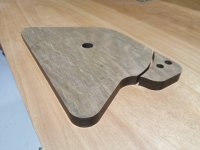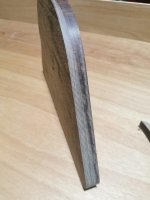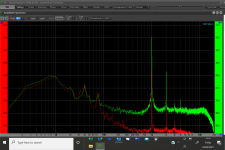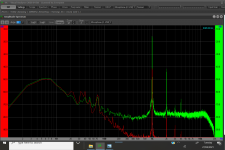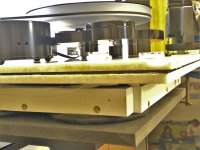JW, do you have a link please for the permali material and prices?
These are some of the permali pieces cut. You can see the edge seems to have light bits in it. I’m not sure what sort of finish it will bring up once sanded etc, looks darker than the panzerholz though.
Attachments
Hi,
The chap is Simin Lear, sales@permalideho.co.uk and this is his number, 01452 411607
In terms of cost I think it was less than £400 for 1m square which is the minimum size. It’s enough for 4 plinths though. I think it was £340...I can’t remember. The panzerholz was £150 for 500x500mm so it’s a lot cheaper in the long run. You can’t get the panzerholz now as I’ve previously mentioned...of course Brexit may have had a bearing on the prices. He’s around Gloucestershire I think so if you’re near that may save postage which was £40.
Thanks JW, i shall investigate, i am also going to experiment with what you see on the Lenco thread of modified/damped surfaces using a spiral routed groove filled with bitumen/sand........may be a dead end, but low cost diy!
Thanks JW, i shall investigate, i am also going to experiment with what you see on the Lenco thread of modified/damped surfaces using a spiral routed groove filled with bitumen/sand........may be a dead end, but low cost diy!
Here is a link to their website, seems they have half a dozen types which always confuses!
M
https://permalideho.co.uk/
Mike, yes they do. I can’t remember which one I got. What I suggest is give simon a call, he talked me through the options. In practice there were only two to choose from in 25mm I think. He may have a cheaper off cut if it’s a particular size. They make a lot of skid boards for Le Mans cars and I think they occasionally have off cuts from them. I needed a certain size so that didn’t work for me.
Thanks JW, i shall investigate, i am also going to experiment with what you see on the Lenco thread of modified/damped surfaces using a spiral routed groove filled with bitumen/sand........may be a dead end, but low cost diy!
Have you got a link to your LH build?
Panzerholz
Mike, jw67,
I doubt that you'll find this economical once shipping to the UK is added. But just in case...
Lucky for me, there's a Canadian distributor fro Panzerholz called BKB Industrial. They offer 20mm Panzerholz in smaller sizes. Here's what they emailed me back in 2020 in Canadian dollars.
Quarter sheet size approx. 42" x 19-1/2":
20mm: CAD 202.50 / piece
+ CAD 15.00 / lot for packaging
b)
Eighth sheet size approx. 21" x 19-1/2":
20mm: CAD 141.25 / piece
+ CAD 5.00 / lot for packaging
Shipping via Canada post within Canada was reasonable. To the UK, who knows.
Hugh
Mike, jw67,
I doubt that you'll find this economical once shipping to the UK is added. But just in case...
Lucky for me, there's a Canadian distributor fro Panzerholz called BKB Industrial. They offer 20mm Panzerholz in smaller sizes. Here's what they emailed me back in 2020 in Canadian dollars.
Quarter sheet size approx. 42" x 19-1/2":
20mm: CAD 202.50 / piece
+ CAD 15.00 / lot for packaging
b)
Eighth sheet size approx. 21" x 19-1/2":
20mm: CAD 141.25 / piece
+ CAD 5.00 / lot for packaging
Shipping via Canada post within Canada was reasonable. To the UK, who knows.
Hugh
Have you got a link to your LH build?
Hi JW, i haven't started the Lenco yet, it is sitting ion the floor in the corner awaiting attention!
I want to only do that once so deciding what to attempt first.
Best
Mike
Thanks for the info Hugh, yes, i think it would work out quite pricey!Mike, jw67,
I doubt that you'll find this economical once shipping to the UK is added. But just in case...
Lucky for me, there's a Canadian distributor fro Panzerholz called BKB Industrial. They offer 20mm Panzerholz in smaller sizes. Here's what they emailed me back in 2020 in Canadian dollars.
Quarter sheet size approx. 42" x 19-1/2":
20mm: CAD 202.50 / piece
+ CAD 15.00 / lot for packaging
b)
Eighth sheet size approx. 21" x 19-1/2":
20mm: CAD 141.25 / piece
+ CAD 5.00 / lot for packaging
Shipping via Canada post within Canada was reasonable. To the UK, who knows.
Hugh
Trouble is i always try to do things cheap as well!
Best
Mike
Mike, jw67,
I doubt that you'll find this economical once shipping to the UK is added. But just in case...
Lucky for me, there's a Canadian distributor fro Panzerholz called BKB Industrial. They offer 20mm Panzerholz in smaller sizes. Here's what they emailed me back in 2020 in Canadian dollars.
Quarter sheet size approx. 42" x 19-1/2":
20mm: CAD 202.50 / piece
+ CAD 15.00 / lot for packaging
b)
Eighth sheet size approx. 21" x 19-1/2":
20mm: CAD 141.25 / piece
+ CAD 5.00 / lot for packaging
Shipping via Canada post within Canada was reasonable. To the UK, who knows.
Hugh
Thanks Hugh, Yes probably a bit pricey but it’s good to know of other sources just in case. It’s very irritating that you can’t get panzerholz over here currently. Hopefully the permali will work out ok.
Hi JW, i haven't started the Lenco yet, it is sitting ion the floor in the corner awaiting attention!
I want to only do that once so deciding what to attempt first.
Best
Mike
Haha ....mine did that for a couple of years.
Completely Off Topic
Hi Mike (and anyone else interested) ,
You requested more information about using the correct reference frame in regards to motor location.
If you poke a suspended sub-chassis turntable the sub-chassis (and all the bits attached to it, arm and platter) bounce all over the place. Of course the last thing you want is the sub-chassis bouncing around. The normal way of dealing with this is to damp the suspension so that the sub-chassis is brought to rest relative to the plinth as quickly as possible. In this scenario you are using the earth as your reference.
This is completely back to front.
The whole point of the suspension is that the sub-chassis remains stationary whilst the rest of the world bounces and vibrates. If you damp the suspension what you are actually trying to do is to damp the motion of the entire earth and bring it to rest relative to the sub-chassis. This is never going to work. Ideally the suspension should be completely undamped so that the sub-chassis can remain as still as possible as the earth vibrates beneath it. In this scenario you are using the sub-chassis as the reference. It is much better to use the thing that you want to be stationary as your reference.
Normally the motor is mounted either on the plinth or in a separate motor pod. A belt then links the motor to the suspended platter. As the platter rotates the drag (torque reaction), due to bearing friction and stylus drag, will try to twist the sub-chassis in the same direction as the rotation. If the sub-chassis were to just twist so far and settle at equilibrium this wouldn't be a problem. Unfortunately what happens is that the twist overshoots the equilibrium point then twists back. This sets up an oscillation in a similar way that a flag flaps in a steady breeze or the reed of a saxophone vibrates. This is the main problem with suspended decks. The normal way of dealing with this is to damp the suspension which takes us back to using the earth as the reference frame and compromises the effectiveness of the suspension. There have been several methods developed to overcome the oscillation without damping the suspension. Origin Live use a leaf spring that doesn't twist but this only isolates vertical motion and not lateral motion. Linn straps the sub-chassis to the plinth using the arm cable. Kronos uses twin counter-rotating platters specifically to counter the oscillation. There is a big hole in the physics behind this idea but apparently it is a fine sounding deck. Another way to minimise the oscillation is to use a very low friction bearing but even with a zero friction bearing you will still have stylus drag. All of these ideas still use the earth as the reference. They isolate the sub-chassis from the earth, then they isolate the motor (though not always) from the earth then strap the sub-chassis and the motor together with a belt.
If you use the sub-chassis as your reference you isolate the earth from the sub-chassis and you isolate the motor from the sub-chassis. In other words you mount the motor on the sub-chassis. This creates a closed system hung from the main suspension. As the motor is on the sub-chassis it cannot twist the sub-chassis and therefore no oscillation is set up. You will, of course, have a similar torque reaction trying to set up an oscillation of the motor on its isolation mount so the motor mount will need to be damped. This will be the case with any compliantly mounted motor regardless of where it is located.
What about motor noise?
If you were to have that mythical beast of a completely vibration free silent motor then mounting the motor directly onto the sub-chassis would be a no-brainer. A motor with a little bit of noise will require some form of isolation.
If you have a really noisy motor then, even with a very compliant mount, too much motor noise would break through. With a noisy motor you cannot mount the motor on the sub-chassis and have to mount it on the plinth/in a separate pod.
There must be a degree of motor noise that if you are below then you mount on the sub-chassis and if you are above you mount on the plinth. With modern high quality motors (especially DC motors) and sophisticated motor controllers the amount of motor noise is low enough that mounting on the sub-chassis is preferable. My motor mounts are made from very squidgy silicone rubber and are very compliant and well damped. The motor is attached to a triangular plate with one mount in each corner. The mounts are quite a large distance from the centre of the motor so the motor suspension system is quite stiff torsionally (preventing oscillation) but is compliant laterally (to minimise vibration transmission). Using a mechanics stethoscope I can hear no motor noise breakthrough to the sub-chassis.
It's not as unusual as you might think.
The decks most people think of when you think of mounting the motor on the sub-chassis are the Pink Triangle decks and their Linn upgrades. A couple of other manufacturers such as Helius have also taken this approach. All Rega decks also fall into this category.
Of course all direct drive turntables and idler drives have the motor mounted on the same platform as the platter and arm.
If you have a solid plinth style of deck and you place it on an isolation platform then the plinth becomes the sub-chassis complete with motor.
I designed my deck to be a cross between a suspended sub-chassis deck and a solid plinth deck with a dedicated isolation platform. The deck and platform are of course optimised to each other.
Mounting the motor on the sub-chassis and using the sub-chassis as the reference seems counterintuitive but if done well the benefits more than outweigh any possible negatives.
Niffy
Hi Mike (and anyone else interested) ,
You requested more information about using the correct reference frame in regards to motor location.
If you poke a suspended sub-chassis turntable the sub-chassis (and all the bits attached to it, arm and platter) bounce all over the place. Of course the last thing you want is the sub-chassis bouncing around. The normal way of dealing with this is to damp the suspension so that the sub-chassis is brought to rest relative to the plinth as quickly as possible. In this scenario you are using the earth as your reference.
This is completely back to front.
The whole point of the suspension is that the sub-chassis remains stationary whilst the rest of the world bounces and vibrates. If you damp the suspension what you are actually trying to do is to damp the motion of the entire earth and bring it to rest relative to the sub-chassis. This is never going to work. Ideally the suspension should be completely undamped so that the sub-chassis can remain as still as possible as the earth vibrates beneath it. In this scenario you are using the sub-chassis as the reference. It is much better to use the thing that you want to be stationary as your reference.
Normally the motor is mounted either on the plinth or in a separate motor pod. A belt then links the motor to the suspended platter. As the platter rotates the drag (torque reaction), due to bearing friction and stylus drag, will try to twist the sub-chassis in the same direction as the rotation. If the sub-chassis were to just twist so far and settle at equilibrium this wouldn't be a problem. Unfortunately what happens is that the twist overshoots the equilibrium point then twists back. This sets up an oscillation in a similar way that a flag flaps in a steady breeze or the reed of a saxophone vibrates. This is the main problem with suspended decks. The normal way of dealing with this is to damp the suspension which takes us back to using the earth as the reference frame and compromises the effectiveness of the suspension. There have been several methods developed to overcome the oscillation without damping the suspension. Origin Live use a leaf spring that doesn't twist but this only isolates vertical motion and not lateral motion. Linn straps the sub-chassis to the plinth using the arm cable. Kronos uses twin counter-rotating platters specifically to counter the oscillation. There is a big hole in the physics behind this idea but apparently it is a fine sounding deck. Another way to minimise the oscillation is to use a very low friction bearing but even with a zero friction bearing you will still have stylus drag. All of these ideas still use the earth as the reference. They isolate the sub-chassis from the earth, then they isolate the motor (though not always) from the earth then strap the sub-chassis and the motor together with a belt.
If you use the sub-chassis as your reference you isolate the earth from the sub-chassis and you isolate the motor from the sub-chassis. In other words you mount the motor on the sub-chassis. This creates a closed system hung from the main suspension. As the motor is on the sub-chassis it cannot twist the sub-chassis and therefore no oscillation is set up. You will, of course, have a similar torque reaction trying to set up an oscillation of the motor on its isolation mount so the motor mount will need to be damped. This will be the case with any compliantly mounted motor regardless of where it is located.
What about motor noise?
If you were to have that mythical beast of a completely vibration free silent motor then mounting the motor directly onto the sub-chassis would be a no-brainer. A motor with a little bit of noise will require some form of isolation.
If you have a really noisy motor then, even with a very compliant mount, too much motor noise would break through. With a noisy motor you cannot mount the motor on the sub-chassis and have to mount it on the plinth/in a separate pod.
There must be a degree of motor noise that if you are below then you mount on the sub-chassis and if you are above you mount on the plinth. With modern high quality motors (especially DC motors) and sophisticated motor controllers the amount of motor noise is low enough that mounting on the sub-chassis is preferable. My motor mounts are made from very squidgy silicone rubber and are very compliant and well damped. The motor is attached to a triangular plate with one mount in each corner. The mounts are quite a large distance from the centre of the motor so the motor suspension system is quite stiff torsionally (preventing oscillation) but is compliant laterally (to minimise vibration transmission). Using a mechanics stethoscope I can hear no motor noise breakthrough to the sub-chassis.
It's not as unusual as you might think.
The decks most people think of when you think of mounting the motor on the sub-chassis are the Pink Triangle decks and their Linn upgrades. A couple of other manufacturers such as Helius have also taken this approach. All Rega decks also fall into this category.
Of course all direct drive turntables and idler drives have the motor mounted on the same platform as the platter and arm.
If you have a solid plinth style of deck and you place it on an isolation platform then the plinth becomes the sub-chassis complete with motor.
I designed my deck to be a cross between a suspended sub-chassis deck and a solid plinth deck with a dedicated isolation platform. The deck and platform are of course optimised to each other.
Mounting the motor on the sub-chassis and using the sub-chassis as the reference seems counterintuitive but if done well the benefits more than outweigh any possible negatives.
Niffy
Niffy, thanks so much for that in depth insight. i am going to read that many times and see how it filters into and affects my thought processes. hopefully it will move my understanding forward a touch towards yours as well. interesting (i think) arm developments will be posted in a week or so...............Hi Mike (and anyone else interested) ,
Niffy
Mike
Hi Mike (and anyone else interested) ,
You requested more information about using the correct reference frame in regards to motor location.
The whole point of the suspension is that the sub-chassis remains stationary whilst the rest of the world bounces and vibrates.
Niffy
I have read, thought and experimented Niffy.
I enjoy working with things that are very inexpensive as it seems attractive to make something that sounds well but costs little.
I have recently tried various assemblages of Avonite (Corian like worktop offcuts, free!) Mass loaded 4mm vinyl sheet (ex bass absorber experiment), sandboxes and inner tubes.
The inner tube isolates whatever is above it successfully from whatever is below and vice versa. However one 13" tube wobbles when cueing, so i shall try 3 small ones so that the side going down doesn't push the other side up, i expect to find this more stable in use.
A stack of 12mm avonite/4mm MLV/12mm avonite measures to absorb/stop transmission of various low frequency spikes.
So my current intention is to mount the 3 small inner tubes on the wall shelf (that is already well isolated from footfall etc and treat that barrier as isolating the world below from the subchassis above. The subchassis above being a hopefully stationary/isolated layer and therefore the reference layer to be made from a sandwich of 12mm avonite/4mmMLV/12mm avonite that measures better than the avonite alone.
I will experiment with that sub chassis having either or both of a sandbox support and sand container dampers, both of which measure to reduce some bass spikes, i assume by sinking some energy away.
The motor pod, TT and TA will all be mounted rigidly to the top of the sub chassis and therefore firmly inter-connected to this reference layer.........
Right now i have that set up but with only a sound box isolating the reference layer form the earth and it doesn't do it very well as demonstrated by full volume tap tests, however it sounds good, percussion having noticeably good attack and presence.
Anyone with further input please?- before i take the plunge and outlay the massive expenditure on 3 new small inner tubes?!
I once built a suspended plinth using three spider & Voice Coil assemblies. The coils were in magnet gaps so I could dial in damping by varying the load on the coils. Even thought about adding a fourth coil for sensing and driving the other three with an "anti-vibration" signal for an active suspension.. Never got around to it. Worked great in the vertical domain.. Not it all for horizontal movement.
A very interesting thought SB, active isolation, fortunately i have enough going on to not follow that route (yet!)I once built a suspended plinth using three spider & Voice Coil assemblies. The coils were in magnet gaps so I could dial in damping by varying the load on the coils. Even thought about adding a fourth coil for sensing and driving the other three with an "anti-vibration" signal for an active suspension.. Never got around to it. Worked great in the vertical domain.. Not it all for horizontal movement.
Has someone tried that or similar?
M
Hi Mike,
It looks like you have all the ingredients for a really good isolation platform.
I used to use inner tube isolation underneath all of my equipment. Alas, WAF has put an end to that. Inner tubes work best if the pressure is kept low and the mass they are supporting is high. This will set the systems natural frequency as low as possible. I would recommend putting the sand-box on top of the inner tube(s) for a couple reasons. Firstly it will supply the mass the tubes like for best performance. If using three or more tubes try to keep the pressure in each of them as similar as possible. In order to level the supported platform/sand-box you will need to make sure that the centre of mass is at the centre of the triangle/square created by the tubes. This will tune all the tubes to the same natural frequency. The system can be fine tuned by adjusting the pressure of the individual tubes. If you are using a wall mount it is a good idea to make some holes in the shelf the tubes rest on so that the valves are accessible from beneath.
The second reason for putting the sand-box on top of the tubes is that it will act as somewhere for any vibrations created by the deck itself to go, a floating ground of sorts. Your current reference sandwich panel sounds ideal. I would have this directly in contact with the sand in the box so that it couples the deck as directly to the sand, where vibration will be absorbed, as possible. It might be an idea to add studs to the bottom of the panel to maximise this coupling.
Niffy
It looks like you have all the ingredients for a really good isolation platform.
I used to use inner tube isolation underneath all of my equipment. Alas, WAF has put an end to that. Inner tubes work best if the pressure is kept low and the mass they are supporting is high. This will set the systems natural frequency as low as possible. I would recommend putting the sand-box on top of the inner tube(s) for a couple reasons. Firstly it will supply the mass the tubes like for best performance. If using three or more tubes try to keep the pressure in each of them as similar as possible. In order to level the supported platform/sand-box you will need to make sure that the centre of mass is at the centre of the triangle/square created by the tubes. This will tune all the tubes to the same natural frequency. The system can be fine tuned by adjusting the pressure of the individual tubes. If you are using a wall mount it is a good idea to make some holes in the shelf the tubes rest on so that the valves are accessible from beneath.
The second reason for putting the sand-box on top of the tubes is that it will act as somewhere for any vibrations created by the deck itself to go, a floating ground of sorts. Your current reference sandwich panel sounds ideal. I would have this directly in contact with the sand in the box so that it couples the deck as directly to the sand, where vibration will be absorbed, as possible. It might be an idea to add studs to the bottom of the panel to maximise this coupling.
Niffy
Hi Mike,
It looks like you have all the ingredients for a really good isolation platform.
Niffy
Hi Niffy and all, so with these constituents in place for tests i have a before and after, SS597 before, SS607 after.
Normally there are some fine tuning experiments to have small further improvements as well.
It seems to me the signal is the best part of 5db higher, i never understand that, but the noise floor etc is in parts several db lower as well and generally smoother.
A sand damper pot on the top plinth demonstrated a bit of smoothing of peaks and troughs as well, so i might try sand filled channels in the avonite sandwich............
In the pic you can see starting at the bottom the wall shelf which has MLV strips between it and the black MDF, this is the "earth" then on the MDF there are four 8" inner tubes, which behave acceptably in terms of handling, cueing etc, i havent tried pressure experiments yet. there is just a few mm of movement available.
The sand box sits on these tubes as the sink for the reference layer of two avonite sheets with MLV between on which all of the TA, TT and motor pod are sat.
When i have refined this i will put a skirt on the top layer which will cover all the lower layers and look smart?
Now i can get back to rework of the TA on topic!
M
Attachments
Wondering if anyone can suggest where to get ballpoint pen tips? Couldn’t find on ebay or aliexpress.
I just buy a 20 pack of pens and pull the tips out..............I have not found a supplier of just the tips and using up 8 pens would take a long time.
If you can find a size that fits a drill hole or mounting tube readily that is a nice advantage in building a symmetrical machine.
Mike(and anyone else interested)
I have just received an email from a chap who has started supplying
Panzerholz to the Uk Hifi Diy market. £200 for approximately 500x500x25mm. Plus postage. Let me know if you need contact details.
A bit pricey but at least we can get hold of it now.
I have just received an email from a chap who has started supplying
Panzerholz to the Uk Hifi Diy market. £200 for approximately 500x500x25mm. Plus postage. Let me know if you need contact details.
A bit pricey but at least we can get hold of it now.
- Home
- Source & Line
- Analogue Source
- DIY linear tonearm
